Understanding that communities gain intangible benefits from Public Art—interpretation, education, inspiration and aesthetic beauty to name a few—SFU Community Trust has set out to thoughtfully create a platform for both established and emerging artists in order to bring permanent and temporary pieces to the UniverCity community.
In a little over 10 years, the Trust has amassed the beginnings of a unique and varied public art collection with the support of its development partners—all of whom have embraced the unique character of the residential community on Burnaby Mountain. Beginning in 2007 with Yellow Fence by Erica Stocking, public art has been purposefully integrated into the design of each parcel of land developed.
If you’re a newcomer to UniverCity, as you embark upon ARTWALK today with this book in hand, you’ll undoubtedly learn a thing or two about the community and some local artists—and if you’re an old hat around here, perhaps you’ll see and appreciate something new on your journey that you have never noticed before.
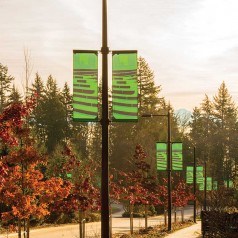
Near As Far As Far As Near
Devon Knowles
Arthur Erickson intended his design of the Simon Fraser University campus to remain in harmony with Burnaby Mountain, using shallow stepped terraces and emphasizing horizontal planes that echo the landscape contours. To cross through the site is to experience stairs in all their aspirational associations and perspectival instabilities: we ascend and descend and ascend once more. At the top of the stairs we find stairs. Stopping to get our bearings in one of many lateral expanses we notice multiple staircases join and separate in studied horizontal geometries. Devon Knowles has titled her new work Near As Far As Far As Near , echoing this formal symmetry in its very syntax. Her title lays out spatial relationships and reverses them, evoking a certain back and forth rhythm. In the series of banners devised for the 75 lamp standards along University High Street and selected intersecting roads, four images of the campus staircases repeat …
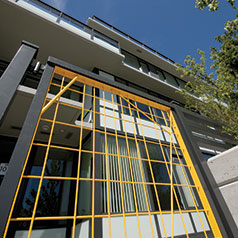
Yellow Fence
Erica Stocking
Drawn lines—forming grids, plans and abstract patterns—are a powerful way of plotting the future, of imagining and communicating a form to be built, and a rational method of claiming, measuring and negotiating the dense forest that defines our west coast landscape. As we move through our day-to-day geography, we bear down upon this invention, as a system to understand time and space and the shifting conditions of our own particular orientation. Yellow Fence draws upon this history of thinking about time and space as well as the materials and means by which boundaries are created, re-drawn and permeated in the complex use of the built environment by communities of people. Abstraction, and its relationship to the imaginary, is made concrete in the objects we dwell within and walk upon, for “within the abstract, there can be a lived experience of order.” In developing her artwork, Erica Stocking considered Arthur Erickson’s original response …
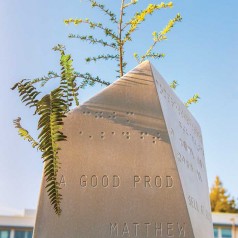
EcoSoMo
Matthew Soules
EcoSoMo, an abbreviation of Ecological Social Modules, is a series of sculptural forms clustered evenly along the full length of University High Street between Tower and Crescent. Separately, the components are asymmetrical and dynamic shapes that fit together like puzzle pieces. Placed together, they support the interaction of people, plants and wildlife through elevated planters, seating and rain pool birdbaths. Local plantings erupt from the summits of ‘volcano’ shaped obelisks, nestled close to rain pool forms that create micro-habitats for local birds. Beneath these, seating modules and kiosk-like forms suggest a sociable platform for gathering, resting and conversation. Their placement introduces multiple rhythms along the busy streetscape: the modules repeat and recombine systematically; perennial plantings flourish and recede with the season, and precipitation gathers and ebbs away. While there is an ancient sensibility in the architectural references of obelisk and pedestal, the light and clean surfaces, modular construction and systematic placement lend …
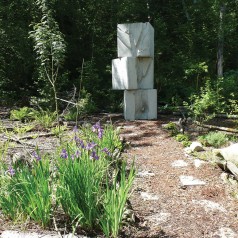
Concrete Tree Imprint
Amelia Epp and Kevin Sandgren
The first work of public art initiated by the SFU Community Trust at UniverCity is Concrete Tree Imprint, installed in 2006. Amelia Epp and Kevin Sandgren, undergraduate students in Fine Arts and the Humanities at that time, responded to an open call for proposals from the SFU community by the 2004 SFU Undergraduate Semester in Dialogue, led by Director Mark Winston. A student initiative, the ‘Art Takes Route’ program engaged Dialogue students in conceiving the vision for the competition, managing its implementation and arriving at the final decision on the successful entry. As a consideration of the abrupt change that was about to happen, Epp and Sandgren’s proposal focused on the contrasts and connections between the natural landscape and the new community that was to come. The artwork drew directly from its surroundings over the two years of its development: surroundings that have changed markedly since its completion. In an area cleared …
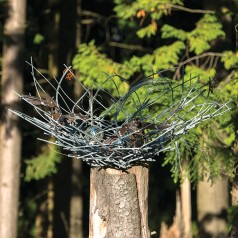
Nest with Chrome Eggs
Bruce Voyce
Bruce Voyce has long believed that art has transformative power, opening the minds and hearts of others. Public art shapes shared spaces into places of inspiration and connection. By exploring the interface between nature and humanity, Voyce’s work, including Nest with Chrome Eggs celebrates life. Voyce’s realization of the public imagination by changing a passing moment into something mysterious and beautiful, utilizes an evolving exploration of materials. Hybrid forms are created that are simultaneously natural and artificial. His sculptures read in a way that is familiar and enigmatic—there is a step beyond self-expression, towards illuminating physical consciousness. Sculpture specifically can interconnect the realms of art, science, nature and humanity. Public art can act as a unified gesture of permanence. Nature gently reclaims technology; the landscape is integrated with the art, and the art with the land. With these principles in mind, the environment becomes a theatre, creating a world of possibilities and wonder. Each …
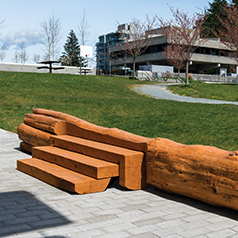
Nightswimming
Brent Comber
Free play needs space – to launch quick and slow movements, for loud and quiet activity, for gathering in groups and for being on one’s own. Within the expansive and multi-level play space at UniverCity’s Childcare Centre, space2place designers and local artists have collaborated on creating an environment in which all these forms of experimentation and performance can co-exist and overlap. The environment they have created invites exuberance and imagination, and through the carefully chosen natural materials of three of its features, expresses a reverence for the forests of the west coast. Titled after a resonant memory from Brent Comber’s childhood, Nightswimming is encountered at the entrance to the Centre. Three hefty steps are hewn from the middle section of a nineteen-foot Western Red Cedar, while preserving the original girth of the log on either end. Sourced directly from the site, it has been skinned of bark, while preserving

Rootwad Cedar Climber
Warren Brubacher
Set in the sand at the Centre’s ground level, an up-ended stump evokes the discoveries to be found on a day at the beach. In contrast to the terraced plantings and curved concrete pathways that encircle it, the stretched limbs, knees and elbows give this object creature-like qualities. This specimen can bear weight, and can indulge the impulse to balance, swing and jump. It cradles a boulder in the tangle of roots, and its knots and variegated skin reward both visual and tactile curiosity. Pockets of shade and small sheltering bays are formed at its base, inviting experiments in crafting miniature worlds. Warren Brubacher states “There are only pockets of the original forest remaining within the BC rainforest and the ancient stumps and remnants that are left behind from logging here in the Squamish area are the treasures that I gather.” This irregular ‘wild wood’ carries with it centuries of history in the gnarls, twists and burls that deem …
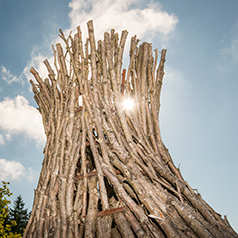
Woven Huts
Alastair Heseltine
Set in the sand at the Centre’s ground level, an up-ended stump evokes the discoveries to be found on a day at the beach. In contrast to the terraced plantings and curved concrete pathways that encircle it, the stretched limbs, knees and elbows give this object creature-like qualities. This specimen can bear weight, and can indulge the impulse to balance, swing and jump. It cradles a boulder in the tangle of roots, and its knots and variegated skin reward both visual and tactile curiosity. Pockets of shade and small sheltering bays are formed at its base, inviting experiments in crafting miniature worlds. Warren Brubacher states “There are only pockets of the original forest remaining within the BC rainforest and the ancient stumps and remnants that are left behind from logging here in the Squamish area are the treasures that I gather.” This irregular ‘wild wood’ carries with it centuries of history in the gnarls, twists and burls that deem …
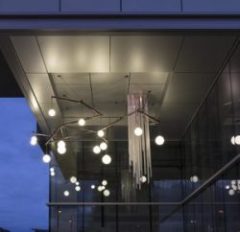
Cosmic Chandelier
Holly Ward
Hovering within the two-story atrium cut away from the façade of CentreBlock, and surrounded by its solid grey reflective surfaces, Cosmic Chandelier marks the transition from the streetscape of University High Street to the private residences and businesses within. Programmed to respond to changes in ambient light and designed to capture the motion of the air, the artwork rewards the ongoing observation of viewers as they pass through during the habitual movements and pauses of everyday life. Cosmic Chandelier pins together futuristic materials and technologies with earlier innovations in manipulating light. Suspended chandeliers began to be found in prosperous homes in the 16th century, beginning simply as candles mounted on spiked timbers. Through ongoing iterations, they became platforms for aesthetic and functional investigations of light, using reflective materials such as mirrored glass, polished metal and quartz crystals. With the introduction of leaded glass, which was easier to work and better at refracting …
